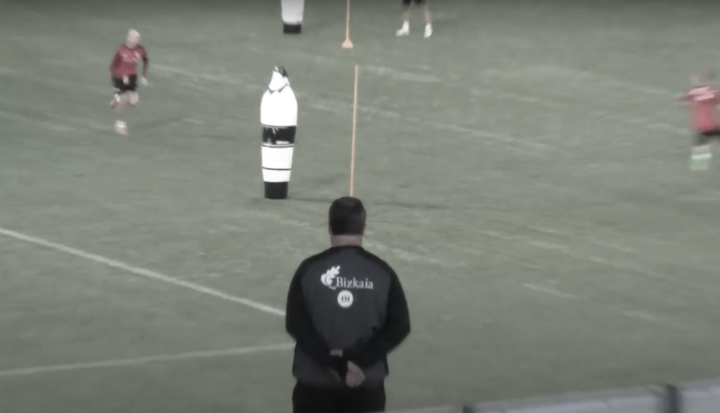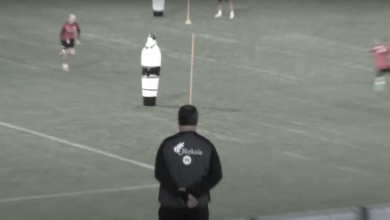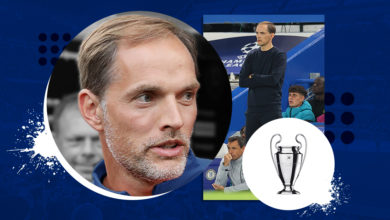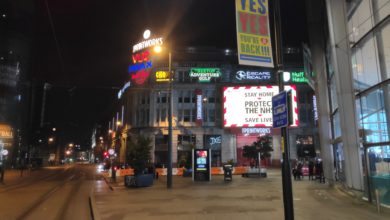Spying on Marcelo Bielsa: Athletic Bilbao in Helsinki
A complete analysis of Athletic Bilbao's training session in August 2012.
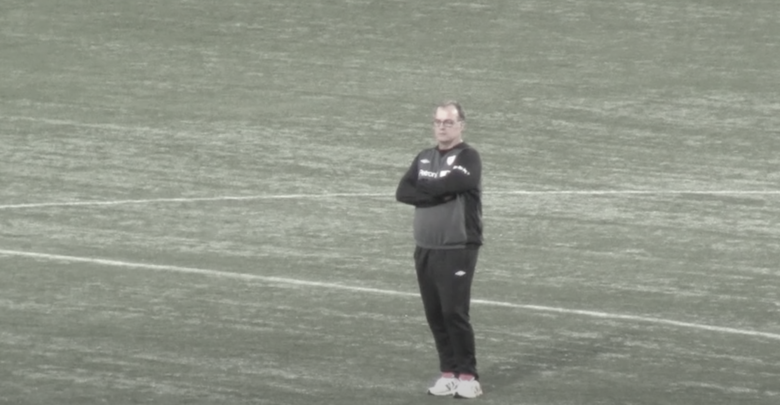
These articles were first published in Finnish in May 2020 and translated into English by Tuomas Tiippana (@tuomastiippana on Twitter).
Part 1: Spying from the rocks
It was August of 2012 in Helsinki when I caught myself standing on the cliff overlooking the stadium where Marcelo Bielsa was preparing his Athletic Bilbao side for the clash against HJK, the biggest and most successful club in Finland. Athletic Bilbao defeated HJK at San Mames 6–0. The match in Helsinki ended 3–3.
Bielsa is known for being the contrarian in the footballing world. The influence of the Argentinian has been immense for coaches around the world.
Athletic Bilbao prepared carefully for the training session. The vast coaching staff of Athletic Bilbao took cones and dummies to their places well in advance of the session. During the session itself the focus was on taking all the unnecessary equipment off the pitch – there was no time for building something new when the session had started.
The total time spent for the first six drills was only 12 minutes. Bielsa himself followed the action from a distance while the coaching staff took care of the practical side of things. The squad was divided into small groups of about five players. According to Bielsa training in these small groups of maximum five players is the most efficient way to practice football. Link to the first part of the training session:
In the following chapters we dive into the details of the drills on the above video. The yellow, red and blue dots are players. A normal straight line refers to the movement of a ball while a dashed line describes the movement of a player. Cones and dummies are marked with black dots. In order to highlight the most important details of the drills such as the movements of the players, some cones etc. are omitted. A big thank you to Jussi Leppälahti, a coach and a football analyst, who was a great help with this article!
Drill #1.

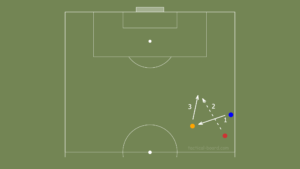
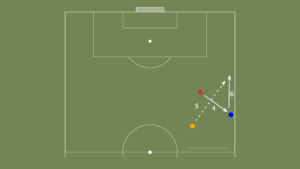
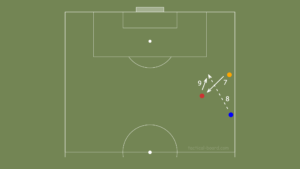
Theme: Cooperation of three players in the wide lanes of the field. Blue: winger, red: right or left back, and yellow: midfielder.
The drill consists of three phases. The goal is to pass to the third player without making them stop their run. Phase 1: Blue passes to yellow (1), red moves (2), yellow passes to red (3). Phase 2: Red passes to blue (4), yellow moves (5), blue passes to yellow (6). Phase 3: Yellow passes to red (7), blue moves (8), red passes to blue (9).
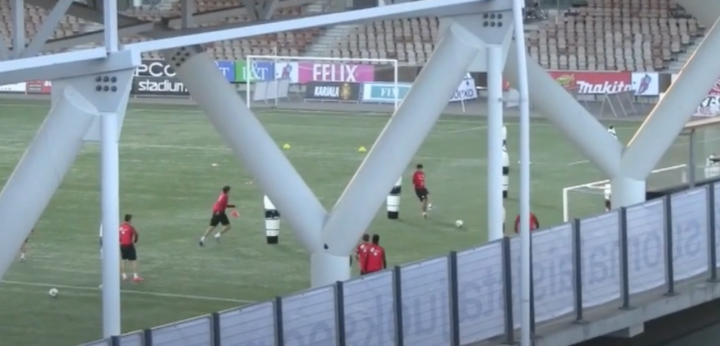
What is Bielsa looking for?
The goal of the first drill of the training session is to prepare the players for the upcoming session. The tempo is fairly easy. Bielsa wants to improve the timings of both passes and runs, playing in between the lines and finding the third player.
In the first phase of the drill the blue player is the first player, yellow the second and red the third. Finding the third player is a very important mechanism in Bielsa’s way of playing football. The idea is to create a free player during the first two passes and then to find this free player in between the lines without making him stop or slow down his run. In the end it all comes down to relentlessly trying to create advantage during the offensive phase of the game.
Defending against the third man is difficult. When the ball is played to the second player the attention of the defending players – including the one tasked to mark the third player – is fixed onto the player with the ball. This gives the third player the time and space needed to find an advantageous position.
Bielsa highlights this type of drills in his coaching methodology. The small group sizes are an integral part of this as it keeps the learning process efficient. He believes that the entire team has to learn the best possible patterns of play in certain key situations. The players have to learn how to interpret the cues arising in these situations.
In the first phase of the drill described above the pass from the blue player to the yellow is a cue for the red to cut in. All of this is based on the fact that a pass is always a collective act. This is how passing differs from shooting: a striker does not necessarily need the help of their teammates in an effort to finish but nobody can pass alone.
The screenshot below illustrates how Athletic Bilbao tried to create similar situations against HJK.
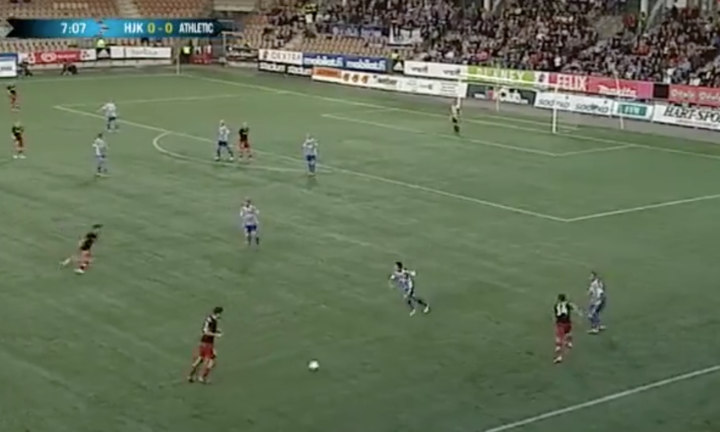
Drill #2.
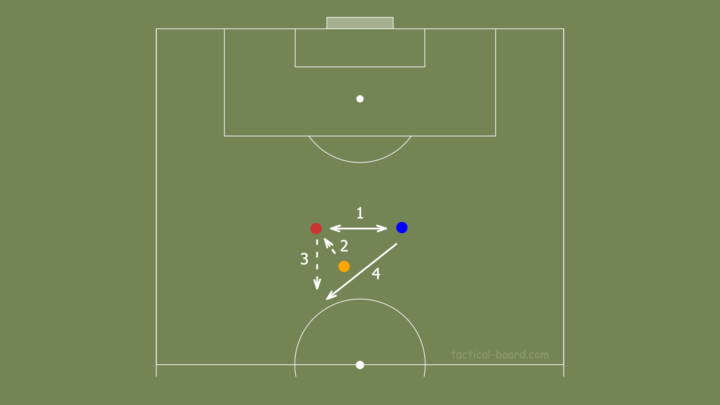
Theme: One-two and defending one-two.
This drill is performed in different parts of the field. Two players (red and blue) are passing the ball (1). The yellow pressures the red player (2). The yellow player tries to interfere the run of the red player with his hands and body while keeping his eyes fixed in the blue player and the ball (3). Blue passes to red (4).
The red and blue players are trying to attract the yellow player with lateral passes. When the yellow takes the bait, the red player tries to run past him. In this situation the yellow tries to stop the run with his right arm by turning 90 degrees to face the blue player.
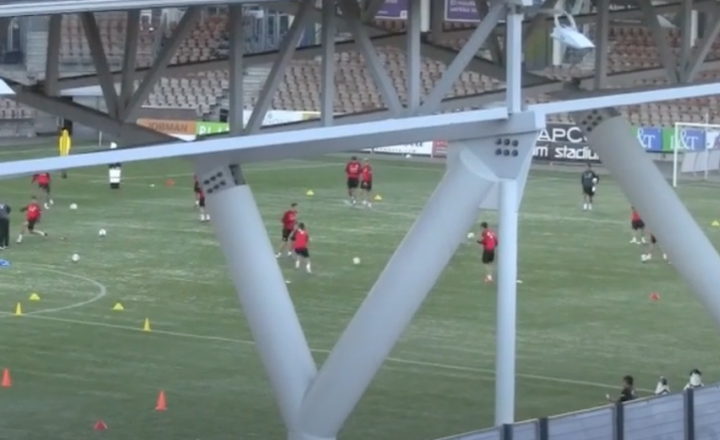
What is Bielsa looking for?
Since it is the second drill of the training session, Bielsa puts emphasis on the speed elements of the players, such as the change of rhythm and shift of the centre of gravity as well as the frequency of steps. Additionally two other key principles of Bielsa are being practiced: attracting the opposition and creating advantage through cooperation two players.
One-two, also known as give-and-go and push-and-run, is a well known mechanism to create advantage. It is said to be developed by Tottenham manager Arthur Rowe. Tottenham won the First Division in 1951 with their unique style of play. Rowe himself gave the credit of developing the one-two to his former manager Peter McWilliam who he played for in the White Hart Lane. Few years later, Tottenham player Vic Buckingham took these ideas to Ajax and FC Barcelona during his managerial career. This played a critical role in the development of ”Total Football” which has subsequently influenced Bielsa and his footballing vision.
The screenshots below depict how Athletic Bilbao created a scoring opportunity with two back-to-back one-twos against HJK.
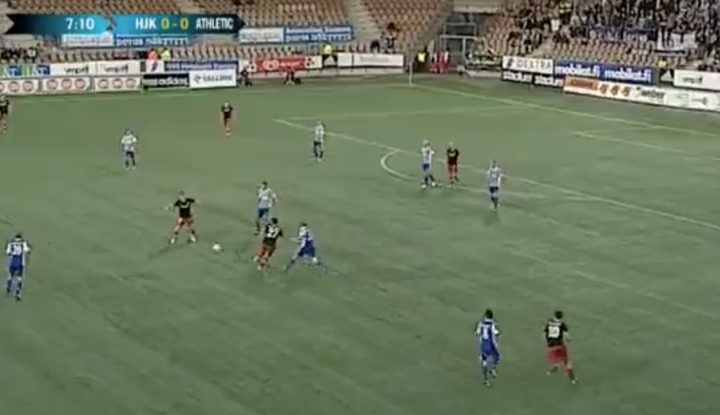
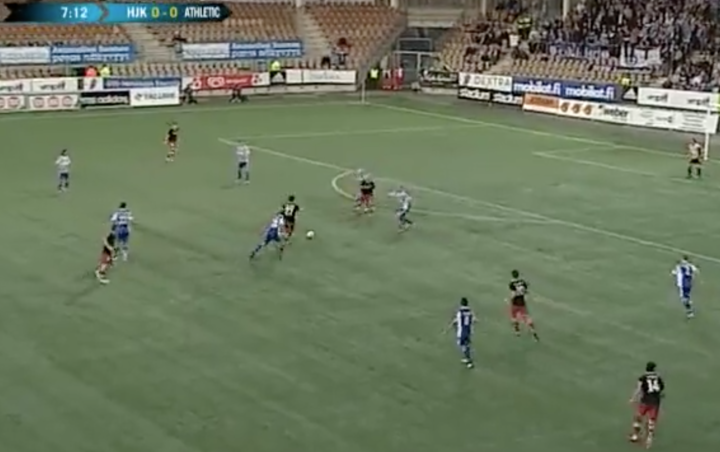
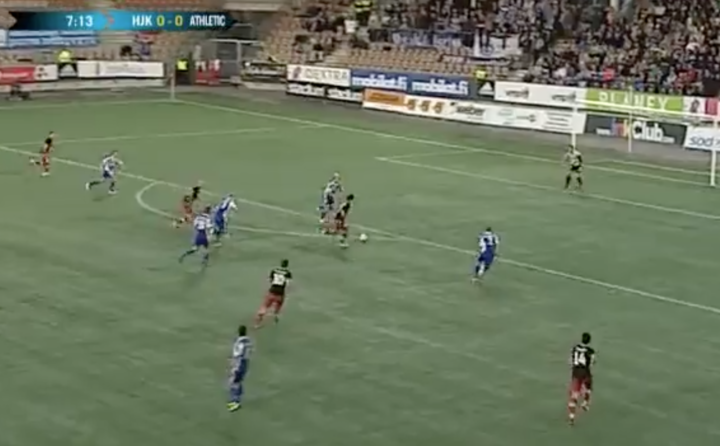
Drill #3.
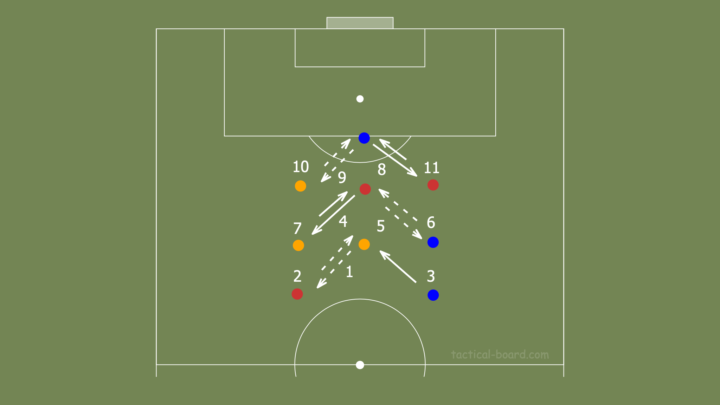
Theme: Vertical rotation in the centre lanes of the field.
The drill has three phases: Phase 1: Red and yellow make a vertical rotation (1 and 2). Blue passes to red on his front foot so that the receiving player can control the ball in front of the opponent (cone) and gets to continue his movement with one touch. Phase 2: Red passes to yellow (4) and rotates now with the blue player (5 and 6). Yellow passes to blue on the move (7). Phase 3: Blue passes to red (8). Blue and yellow rotate (9 and 10) and red passes to yellow (7).
NB! Between every phase, the receiving player dribbles around a cone while the other two shift one step up in the area.
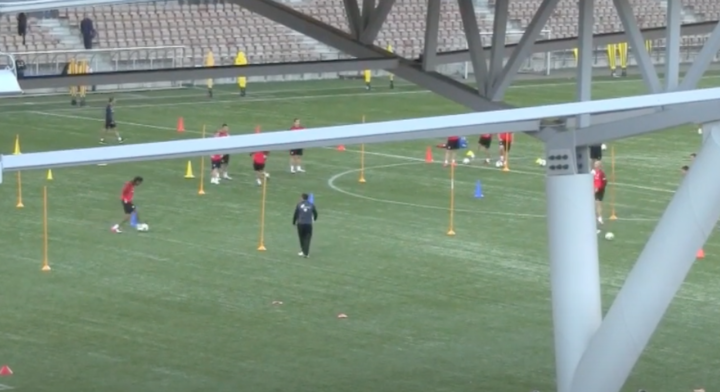
What is Bielsa looking for?
The drills held during the session are set of very specific ways for a formation of 4-3-3 to break opposition lines. The striker of the team comes down to receive the ball in the spaces between lines while making space for the midfielder to run into. For the other midfielder this is a cue to pass to the midfielder making the vertical rotation.
Rotations are hypernym for quick swaps of positions between players. These rotations help to disorganize the opponent and create, for instance, opportunities for the players to unmark themselves from their markers. Constant rotations, both vertical and horizontal, are a key part of the playbook of Bielsa.
One important element present in every drill introduced so far is the consistent nature of the action performed. This effect is created with the multiple phases of the drill; The runs never stop, even if the free player cannot be found after the first rotations.
In the drill the movement of the striker to receive the ball in between the lines is a cue for the midfielder that there is probably space in front of them. At the same time it is a cue for the midfielder holding the ball that a forward pass can be made for the rotating midfielder. In addition to these cues the drill is enriched with timings, playing in between the lines and the third player mechanism.
Rotations are an effective tool to create different kinds of superiorities. Superiorities can be divided in three categories: positional, numerical, and qualitative. In positional superiority a player is in a position from where they can advance the play. The third drill entails a perfect example of this. The player coming to receive the ball unmarks himself from their opponent and can receive the ball without being pressed and is for a short while in an advantageous position to advance the play.
Simultaneously Athletic Bilbao tries to create numerical superiorities around the pitch. Qualitative superiority is the third and final form of superiority. Bielsa trusts Athletic Bilbao to have qualitative superiorities around the pitch. For example, when their striker gets into a 1 vs 1 situation against the centre back of HJK it is most likely a qualitative superiority for the Athletic striker.
Drill #4.
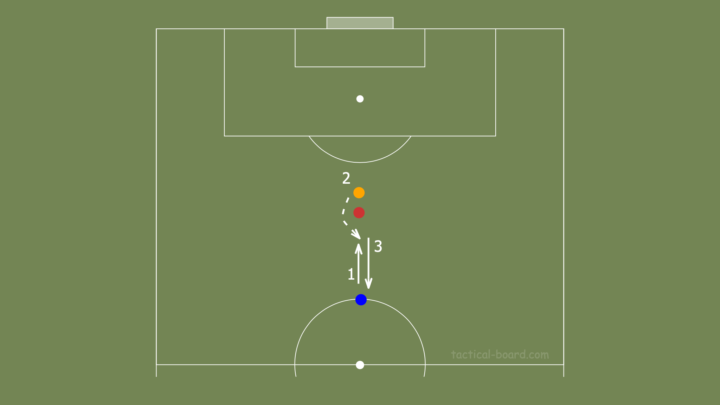
Theme: Anticipation and tackling.
The drill is performed all around the pitch. Bielsa does not seem to pay attention whether the tackle is done from the inside or the outside of the player. After every repetition yellow and red swap places. Blue swaps places with either of the players after about a minute.
Blue passes towards red (1) while yellow is behind the red player on his toes anticipating the pass and ready to make the tackle (2). After the tackle yellow passes the ball back to blue (3).
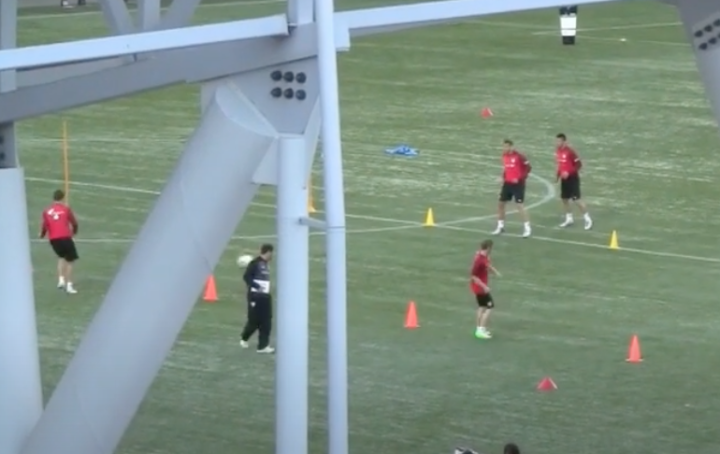
What is Bielsa looking for?
Tackling the ball from opponent just before they are about to receive it is classic Bielsa. The drill is repeated often in the training sessions before a game to make sure it is fresh in the minds of his players.
For Bielsa every action in the pitch implicates a possibility to win both time and space on the field. He believes in the so called Advanced Area Actions method of playing football. This implies that every tackle, dribble or pass has a different value for the team. AAA method emphasizes the importance of actions that can break the lines of the opposition and thus enable the team to win as much space as possible and advance in the field.
Drill #5.
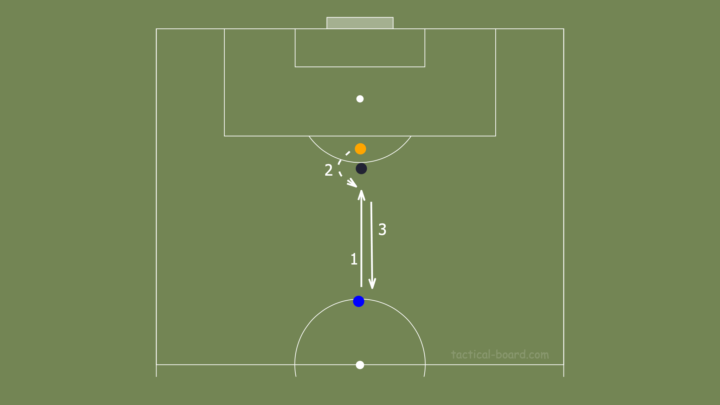
Theme: Anticipation and tackling with a longer pass.
The idea is the same as in the previous exercise but the distance is remarkably bigger. The pass is played towards the dummy (1). The defender makes the interception in front of the dummy and tries to play the ball back to blue as fast as possible (2 and 3).
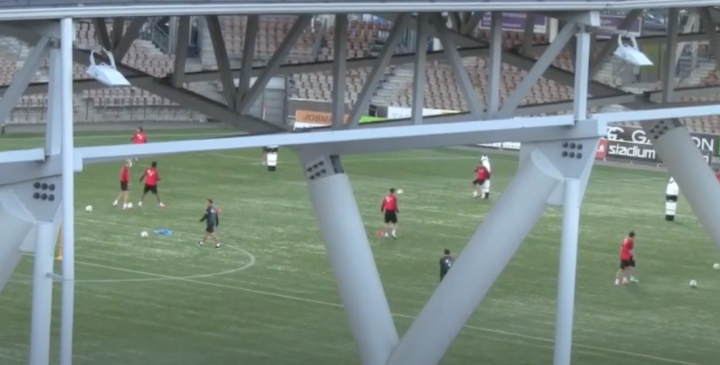
What is Bielsa looking for?
While still continuing with the aforementioned themes, Bielsa is aiming to prepare his player for the artificial grass surface of the venue. The players have to control the ball that is behaving differently in comparison with the natural grass the Athletic players have accustomed to in Spain.
Additionally, Bielsa is preparing for the probable haphazard passes of HJK towards their strikers and midfielders. He wants his team to be able to maintain the pressure with intercepting these passes.
In the drill it is critical for the defender to attack the ball. If the defender hesitates the ball is likely to bounce back up and cannot be controlled fast enough.
Drill #6.
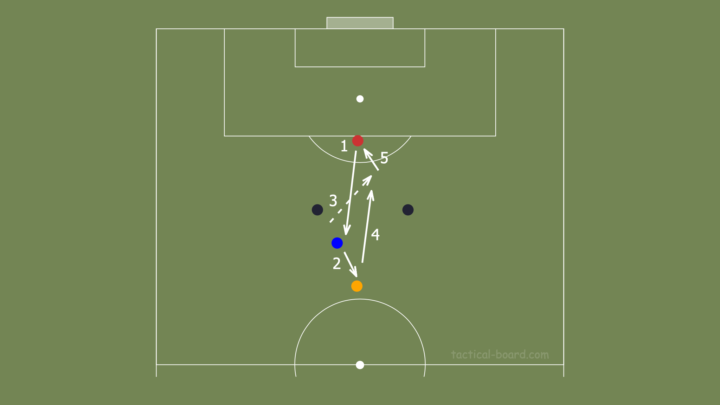
Theme: Playing in the shadow.
In the sixth drill Bielsa is highlighting the importance of playing in the shadow of opposing players. Blue makes himself available so that he can receive the pass from the red player (1) and passes the ball to yellow (2). Immediately after the bass blue makes a run into the shadow of the next opponent (3) while the opponents are fixated by the ball. Yellow then plays the ball between the two opponents to blue (4) that passes it onto red (5) after which the players switch places.
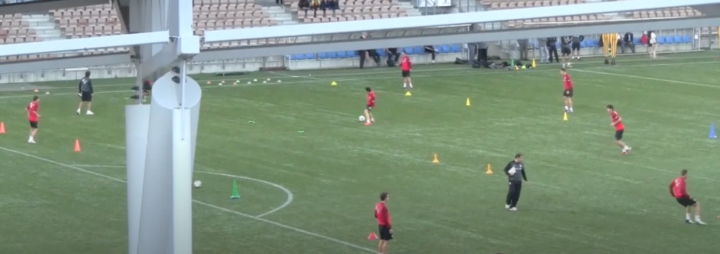
What is Bielsa looking for?
Bielsa wants his Athletic Bilbao side to break as many lines of press as possible with a single pass. This is why the blue player never makes the run towards the player that is going to pass him the ball but stays in the shadow of the opponent. During the match, the blue player (in this case the centre midfielder) runs towards the red (centre back) only if the red is under press and needs an emergency option.
Here Bielsa is also highlighting the need for correct body orientation of the players. Blue has to see both the red and yellow player while looking out for the opponents and keeping himself on the move the entire time.
In football the body orientation of the receiving player can be divided into positive and negative. Despite its name, negative body orientation is not negative in the true meaning of the word but instead implies that a player receives the ball with their back towards the opposition goal. Positive body orientation is the exact opposite, the receiving player is facing the opposition goal and can either pass or dribble forward. Using negative body orientations is a part of the game as are positive body orientations. For example, when a midfielder plays an in-out pass with a defender in order to attract the opponents to press him and thus creating space in the wide lanes.
Correct playing body orientations make it easier for the receiving player to observe the pitch. Often the players try to position themselves so that they can both observe their immediate surroundings and progress straight towards the opponent’s goal.
Bielsa wants the play to roll as smooth as possible right after the player has received the ball. This drill straight from the playbook of Leeds United. Kalvin Phillips makes himself available for a pass in the shadows of opponents pressing players while maintaining the correct body orientation to advance right after receiving the ball.
The series of screenshots below illustrate how Athletic Bilbao advanced into the tight spaces between the lines against HJK.

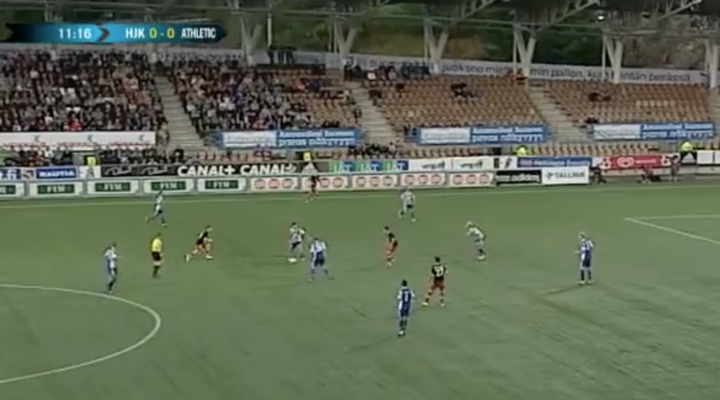
Part 2: Bielsa glancing at the cliff
August of 2012 HJK and Athletic Bilbao went head to head in the second leg of Europa League qualifiers. The day before the match I was able to spy the preparatory training session Marcelo Bielsa held for his team from the nearby cliff overlooking the stadium. The second part of this article series dives even deeper into the methods and mindset of Marcelo Bielsa.
The straight line refers to the movement of a ball while a dashed line describes the movement of players. The numbers indicate the order in which the exercise pans out.
The first leg was a comfortable 6-0 victory for the Athletic Club at San Mamés. However, HJK was able to draw the second leg 3-3.
The head coach of a Finnish second division side JIPPO Joensuu, Jussi Leppälahti, has been a great help with the article series. This article, too, is the end result of seamless teamwork – just like Marcelo Bielsa operates on the field.
The second part of the training session is on YouTube as well. The length of the video is only 12 minutes but again Bielsa manages to cram a lot of content and details into such a short period of time.
Centre-backs and midfielders. At this point of the session Bielsa divides the players into multiple groups based on the playing positions of the players. The centre-backs are training heading accompanied with a few midfielders.
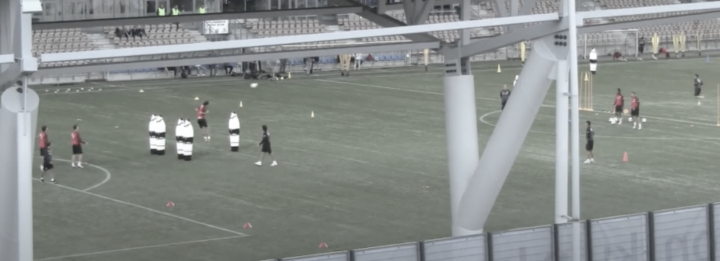
What is Bielsa looking for?
In the first drill the centre-backs are clearing about 28-meter-long balls with force towards the half-way line. Red player lobs the ball towards the dummies (1). The defender anticipates the pass and heads the ball back with force (2 and 3).
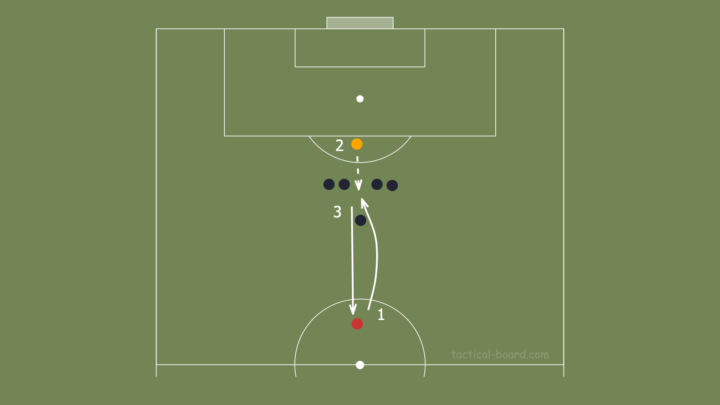
Bielsa does not pay attention to whether the defender jumps with one or both feet – both techniques are used. When jumping with one foot only it is easier to attack the ball fast but the header might fly off uncontrollably. Jumping with both feet makes it easier to position your body behind the ball enabling a more controlled header. A footballer usually jumps using both feet when the opponent manages to interfere with the jump.
Jumping techniques divide many football experts in two schools of thought – Those who highlight the importance of jumping with only one foot and those who think using both feet is imperative. The context of the situation, for instance the trajectory of the ball and the amount of interference from the opposition, affects on the optimal technique.
Bielsa expects HJK to play long passes under pressure in the upcoming match. Dealing with these passes will be essential on keeping the pressure on HJK’s end. The moments after these long passes are critical. There will be opportunities to play in between the lines of the hosts or run straight behind the defenders when HJK is pumping up their defensive line.
In the drill the focus is on the target of the header. Bielsa wants his defenders to head ball to their strikers or midfielders while avoiding situations where HJK wins the ball in dangerous areas, such as the space between Athletic’s defenders and midfielders. Bielsa is convinced that these long balls and Athletic Bilbao’s way of dealing with them is going to be one of the key moments of the match and wants to guarantee that Athletic will be ready for them.
Bielsa worked on tackling and anticipation during the first part of the session as well. This indicates that Bielsa wants to be sure that Athletic Bilbao is ready to attack as efficiently as possible after winning the ball from HJK.
In the following drill the distances are shrank. Red player boots the ball up in the air (1) from about eight meters away from the dummies. The defender anticipates, drops back a bit (2), and heads the ball back to the red player (3). Again, the defenders are leaping with either one or both feet. Bielsa and two other coaches are carefully following the performances of the players. The two other coaches have specific roles, the other is coaching the players kicking the balls while the other observes the defenders heading the ball.
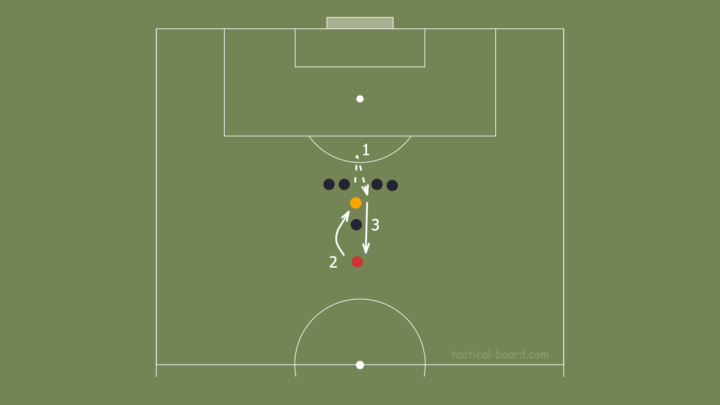
The aggressivity of the defenders is the key. Dummies are falling down in front of the charging defenders. There are a few notable quality factors in play as well. The defenders keep their eyes on the ball throughout the performance. After the initial anticipation, the defenders drop back five quick steps, lower their centre of gravity and attack towards the ball without turning their backs to the ball once during the performance.
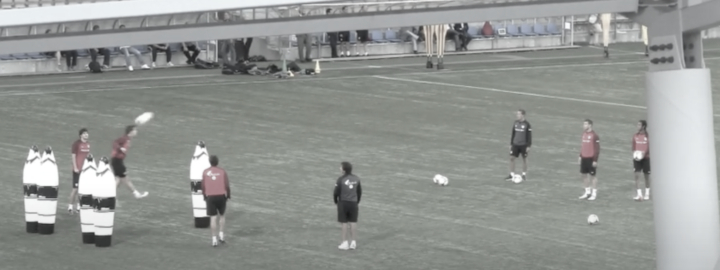
Bielsa is convinced that HJK might cause troubles for his team with winning balls in awkward places. He wants to eliminate this threat and simultaneously put emphasis on the moment when Athletic Bilbao gets the chance to counterattack. The coach responsible for the defenders’ headers gives feedback after every situation. It is important for Athletic not to be overly aggressive and concede free kicks from dangerous areas as the majority of scoring chances HJK gets are likely to come from set plays.
At the same time Athletic is preparing for the future. The centre-backs have to be prepared to deal with crosses and aerial duels in games after the HJK bout as well. This is a trademark quality of Bielsa. He wants to teach his players the undeniable principles and best practices of different key moments and situations of the game.
Fullbacks, wingers and midfielders. While the defenders are honing their clearances and heading, the fullbacks, wingers and midfielders are training three different variations of passing combinations in the wide lanes of the field.
In the first drill the winger cuts in (1) towards the centre of the field from behind the dummy. The midfielder starts his run a tad later (2) and fills up the space made by the run of the winger. The fullback passes to the winger (3) who passes onto the midfielder (4). The drill is a great example of using and training the visual cues arising from the game. A certain stimulation leads to a certain movement. Similar situations were already covered in the first part of the article series.
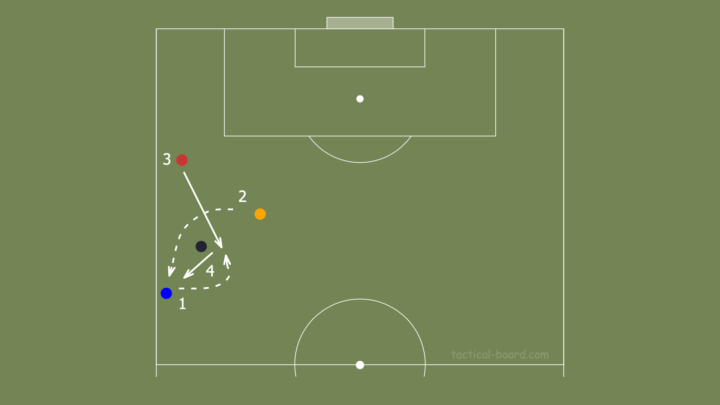
In the second drill the positions of the cones are altered. This time it is the fullback who makes the first initiative (1). This is a cue for the midfielder to pass to the winger (2) who passes the ball onto the fullback who is finishing his run around the opponent’s winger (3).
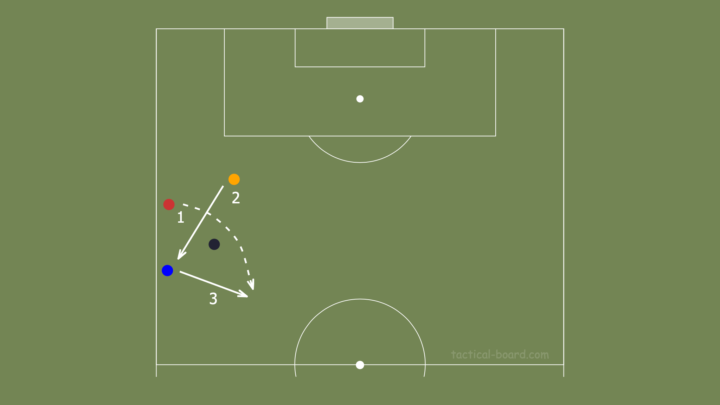
In the third drill the winger cuts in behind the dummy (1). The midfielder passes to the winger (2) who passes to the fullback finishing the rotation of the winger (3 and 4).
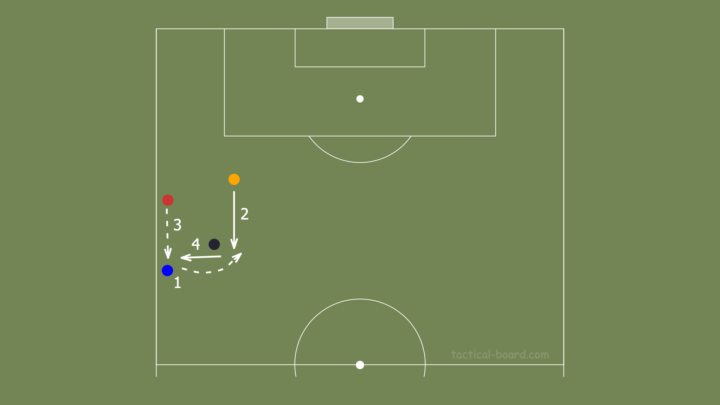
Bielsa tends to use three variations in drills such as the one described above. The players have three opportunities to solve the situation based on the cues arising from the play and the context of the situation. Every variation is trained a maximum of a few minutes, often less. This equals about three to four repetitions per player. The quality of each repetition is essential as Bielsa wants his players to perform at their absolute best during the training session in order to be able to perform the same actions successfully during the match.
What is Bielsa looking for?
This is the part where the intentions of Bielsa get really interesting. The drills are performed in their own half even though during the match the actions are going to be played out much higher in the field. What is Bielsa then really seeking from these drills?
Back home Athletic Bilbao has had a terrible start to their season. The previous Sunday they lost to Atletico Madrid 0-4 away. While the game against HJK is played the following day, the first leg win of 6-0 essentially guarantees that Bielsa can turn his attention to the match against Real Valladolid the next Sunday.
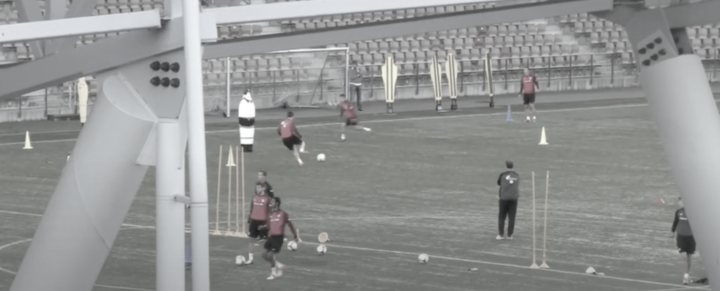
Additionally, it is highly likely that Bielsa wants to use this opportunity to train on the mistakes and problems they encountered in the match against Atletico, for example playing through a high press. Bielsa in known for his intense analysis of both the previous match and the following opposition. This implies that while the HJK game is played one the following day, the actual focus is on their La Liga campaign.
Athletic Bilbao plays against HJK with a 4-1-4-1 formation but on Sunday Bielsa switches to a 4-2-3-1. The drills described in this article suit playing with two pivots as they play closer to the fullbacks than when playing with only a single pivot.
In order to get a real grasp on Bielsa’s way of thinking and playing football we need to take a step back and consider the big picture. Even though there are a myriad of influences from positional play in Bielsa’s football, there are some critical differences as well.
As was mentioned in the first part of the series, Bielsa is a firm believer in the AAA (Advanced Area Actions) way of playing football. It puts a heavy emphasis on the efficiency of individual actions. Every pass, for instance, is judged on how many opposition lines it breaks.
Positional play, on the other hand, favours a more controlled type of football where the ball is played more horizontally. The goal is to find the free player by attracting the opposition to the left hand side of the field and then switch play to the right hand side of the field. In Bielsa Play the goal is to advance as a flock like superorganism and sometimes even push through the opposition press to find advantage and opportunities to break into the spaces between opposition lines.
Organizing the way we think and speak about football helps to interpret what Bielsa Play is really about. Every football club, yet alone every football culture, has its own way of organizing and thinking about football. One way to analyse football is to divide it into principles, subprinciples, and mechanisms.
There is no way of knowing exactly how Bielsa currently dissects football. The process of how one thinks and analyses football lives and evolves constantly inside the head of every coach. Assuming that Bielsa uses the principles-subprinciples-mechanisms way of looking at football he starts to dissect the game from the most important principles towards the smaller details.
What we do know for a fact is that Bielsa looks at football very differently than Pep Guardiola. Guardiola is the poster boy for the modern take on positional play and his process of coaching football highlights the importance of positional games. Bielsa, on the other hand, dissembles his principles of play into smaller details that are then trained within multiple drills in small groups.
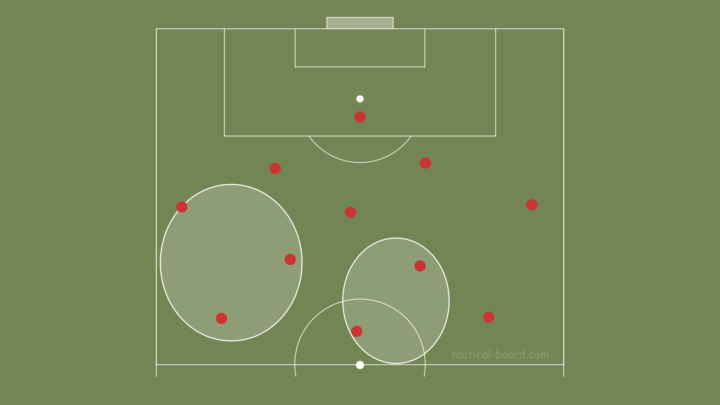
Strikers and midfielders. Similar themes to the previous drills continue with the strikers and midfielders. The drills are performed on their own half but this time in the middle lanes.
There are three players involved with the drills: Gaizka Toquero, Iker Muniain and a third player. This too implies that the Bielsa is already preparing for the upcoming match against Real Valladolid. Against HJK Toquero will be playing the role of the lone striker while Muniain is the other attacking midfielder. In the Valladolid game, however, Muniain will be playing as the number ten while Aritz aduriz starts up front.
One characteristic of Bielsa’s teams is that they never allow opponents to be left unmarked within their own shape. Since HJK played with a 4-2-3-1 (with Joel Pohjanpalo, the Finland’s goal scorer from last weekend against Denmark in Uefa Euro 2020, as their striker), Bielsa opted for the 4-1-4-1. In the game against Valladolid Bielsa switched to a 4-2-3-1 since Valladolid plays with a 4-1-4-1. This way Athletic Bilbao can match the opposition formation, leaving no free players in the middle of the field. The drills trained during the preparatory training session emphasizes the cooperation of a number ten and a striker – the positions specific for the formation to be used in the game against Valladolid.
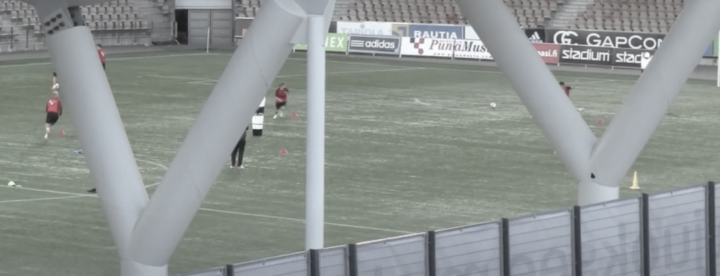
The first drill is a simple vertical rotation in the middle lanes. The number ten makes a forward run to the other side of the dummy (1) while the red player passes diagonally to the striker (2 and 3). The striker passes the ball onto the third player, the number ten.
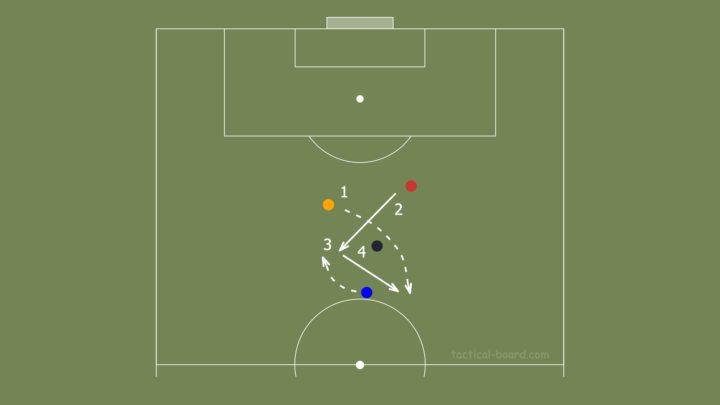
The drill is once again pure Bielsa. The ball is played to the third player on their front foot. This is critical for Bielsa: The ball has to be received while in motion so that the player has the opportunity to break the next opposition line with his next action (dribble, pass etc.). This is all in accordance with the AAA method.
The drill is also a very basic Bielsa drill for breaking the opposition lines. The idea is to disorganize the opponents by attracting. There are two main types of attracting opponents in football: Either with the ball (for example passing the ball laterally or keeping the ball) or without the ball (fixing opponents through own positioning or making runs and dragging the opponent with the run).
When the players on the wide lane drills switch to the next exercise the attackers and midfielders only switch the direction of the drill. Now the striker makes his run to the right side.
The drill is a great example why Bielsa favours hard working attackers. In Bielsa’s system the attackers never stay behind lurking for the next opportunity to get the ball again up in the field but instead are a vital element in the building up phase. This demands lots of both horizontal and vertical rotations, for example. At Leeds United Bielsa picked Patrick Bamford as his striker exactly because of this. The Englishman works hard off the ball and is willing to make the actions that Bielsa demands of him even though he has been sometimes scoring less than his expected goals statistics suggests.
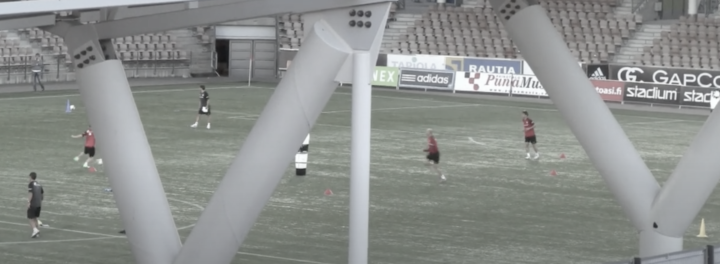
In the third phase Bielsa makes a few changes. The receiving player makes a vertical run instead of running across the pass. The striker makes space for the number ten’s run by making a run away from the ball. This run is meant to drag the opponent’s midfielder away from the tight spaces in the midfield and thus create more space in between the lines.
The drill is challenging despite its simplicity. The players struggle with the timings in the artificial grass of the stadium. The slightly curved run of the striker (1) has to be directed towards the ball so that he can continue the pass from the red player (2) with the inner edge of his right foot (3) to the number ten making his run (4). The details here are important. If the blue player does not use his inner edge of the foot the pass has awkward spins making it harder to receive the ball.
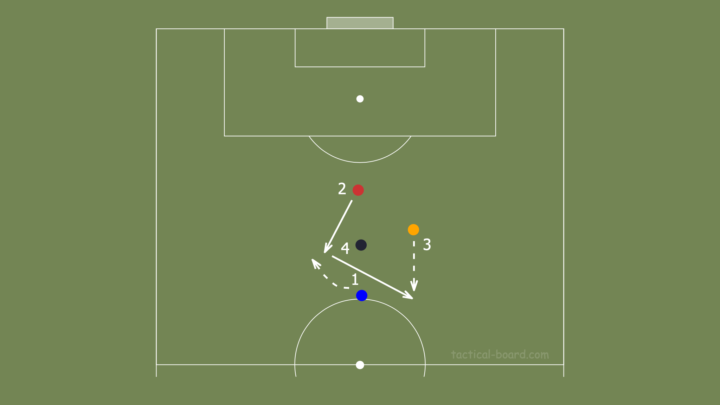
Pressing. Next up Bielsa delivers a true masterpiece in pressing. At the same time, the Argentinian notices the spies videoing his training session on the cliff. Bielsa glances a few times but does not make eye contact. This, too, is classic Bielsa. He is known for not making eye contact with the interviewer during his press conferences and instead stares at his table.
The vast coaching staff the Basque club has built the starting line up of HJK on the pitch from dummies. Beside every dummy there is a yellow stick. The sticks represent the preferred foot of each HJK player. In the defensive line one stick is a bit further up the field than the others. This is likely because Bielsa believes the right back Sebastian Sorsa to progress more than the other defenders.

Bielsa creates two pressing traps for HJK. In the first trap the goal is to make the HJK goalkeeper to play an in-out pass with a defender (1) and then to launch the ball to a fullback (2). The wingers of Athletic Bilbao – Ibai Gómez (left) and Markel Susaeta (right) – press the central defenders from their blind side. When the central defenders receive the ball the left fullback Sorsa is open for a pass. When the ball is played to Sorsa, Athletic’s midfielder (Muniain) presses him vigorously. The other players move toward the left side the field shrinking the spaces around the pressure.
In the other pressing trap Muniain presses the right centre-back of HJK creating an illusion that the holding midfielder Schüller is the free player. When Schüller receives the ball Muniain presses him and receives support from the rest of the team.
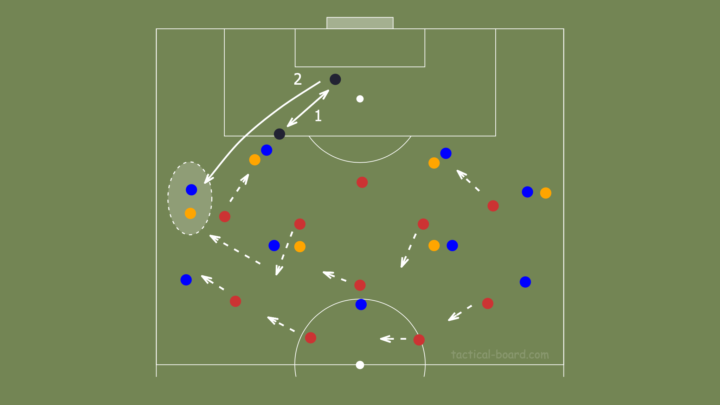
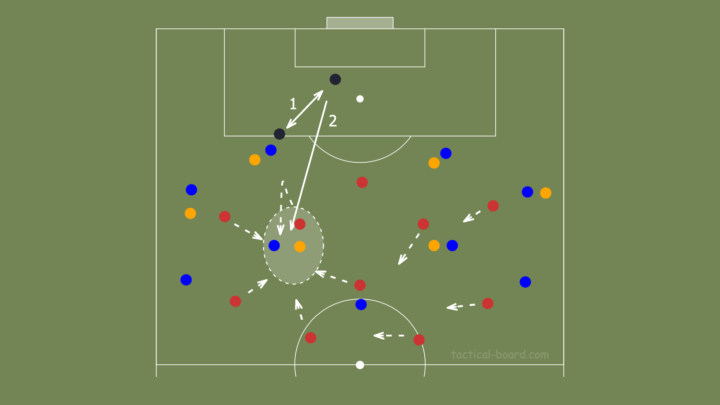
Athletic Bilbao deploys a mix of man marking and zonal marking. Bielsa wants his Athletic side to have one extra player in his defensive line and mark all opponents the near the ball. During his time in Leeds United he has had even more bold approach in few games leaving a man-to-man situation in the defensive line as well.
The pressing exercise does not stop after the successful use of either of the traps. The goalkeeper plays the ball to Toquero or another attacker who gets a chance to score. Bielsa wants that his team does not stop playing after getting the ball.
The match against HJK proves that Bielsa can put his ideas into practice. The following series of four screenshots from the game illustrates the pressing scheme and the player specific actions of central defenders described earlier.
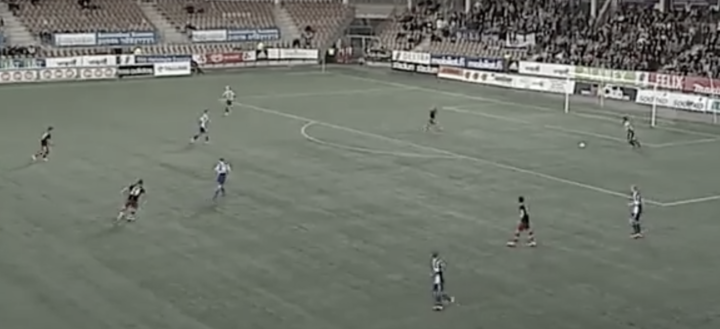
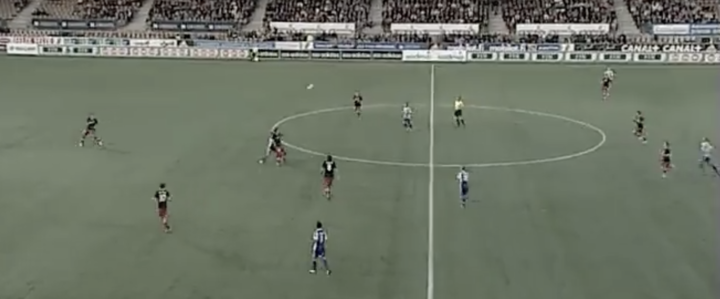
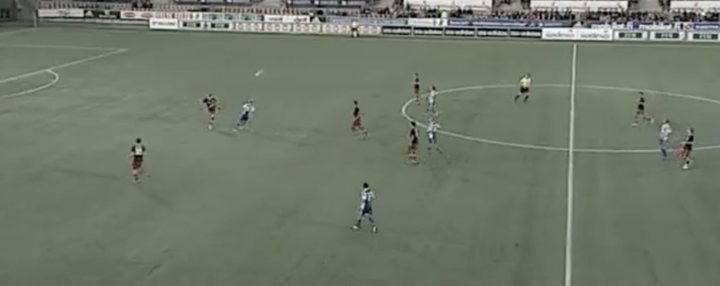
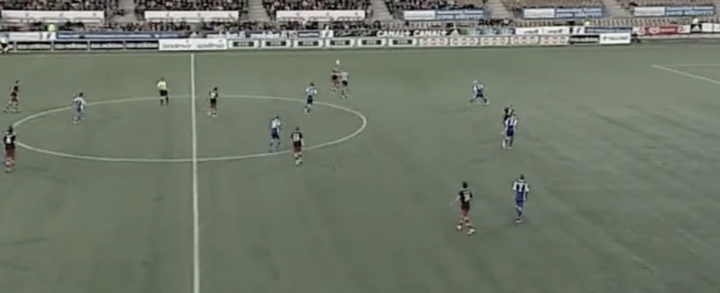
Part 3: A brilliant drill in all its simplicity
In the previous parts of the series we have taken a close look at how Athletic Bilbao prepared for the second leg of Europa League qualifications against HJK. In the final part we analyse two drills and summarize Athletic’s approach and the Bielsa masterclass that was portrayed in the August of 2012 in Helsinki. Thank you for the collaboration, Jussi Leppälahti!
Set pieces from the channels and wide lanes. Bielsa divides his players into two groups in the last part of the training session. The first group trains free kicks. There are cones spread out on the channels and wide lanes of the pitch that mark the spot for the set pieces. There are four coaches involved in the exercise. One is standing in the wall, the second one makes sure that there is no shortage of balls. The third coach is giving feedback to the attacking players while the fourth is coaching the two defenders.

There are two phases in the exercise. First, the player crossing the ball launches it towards the dummies. The defender returns it back or steers over the byline. The next cross is for the attacking players. The defenders try to keep the attackers from attacking the ball or clear away from dangerous areas. This phase of the exercise is done passively – all contacts are avoided. This implies that Bielsa wants mainly to train the crosses – the crosses have to curve towards the dummies. The coaching staff move the dummies every time the set piece is taken from a different place. The timings of both defenders and attackers are also drilled in this exercise.
The footwork of the players is elegant. The players move gracefully and quickly while simultaneously keeping their eyes in the ball and the opponent. The attackers are bouncing lightly on their toes before starting their movement. The communication between the goalkeeper and defenders is remarkable as well. The goalkeeper picks every ball coming towards his area.
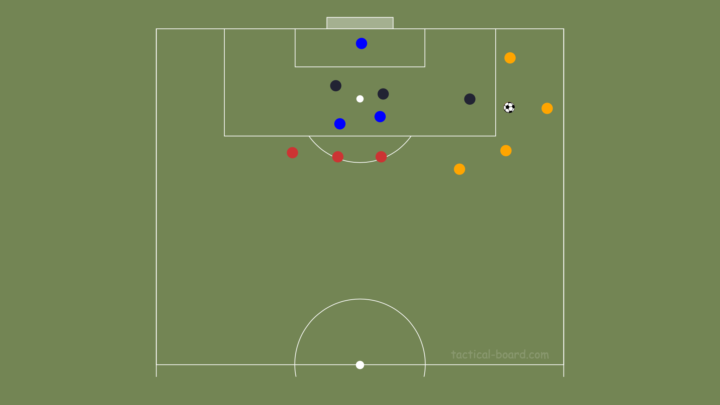
Athletic Bilbao clearly have specific areas they want their set pieces to be played into. Bielsa deploys a pure man marking system on set pieces from wide lanes. While the man marking element is present in the exercise, the main emphasis is on the quality of the crosses.
Interestingly, Bielsa wants his players to be passive while dealing with the set pieces. Moreover, the amount of players is low in comparison to the actual game situation. Both of these details are in place entirely in order to diminish the risk of injuring players.
The defenders and holding midfielder. Bielsa heads to the other side of the pitch to observe the training of his defensive players. An assistant coach is giving feedback for the players and the players make sure to follow the instructions as carefully as they can. The players line up initially in a 4-1 formation (four defenders and one midfielder). When the coach gives the signal they quickly change to a 3-2 formation and then back to a 4-1.
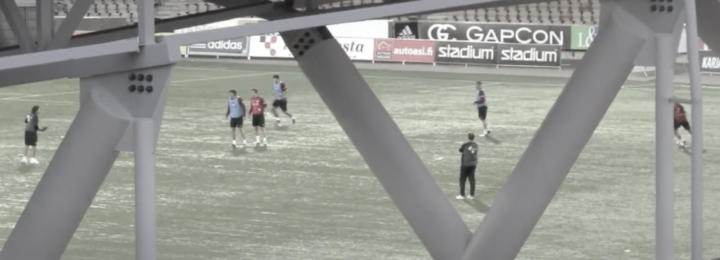
What is Bielsa looking for?
The players are training how the five defensive players should adjust their formation based on the context of the play. The positioning of the midfielder determines how the defensive line moves: If the midfielder moves to his left, the right centre-back jumps to his side and vice-versa. Simultaneously the other three defenders close the gap left open in the middle.
Bielsa is known for changing his formation to a 3-4-3 if the opponent deploys a 4-4-2. For Bielsa it is important to leave an extra player in the defensive line. The midfielders can man mark their direct opponents while leaving the three attackers to deal with four opposition defenders.
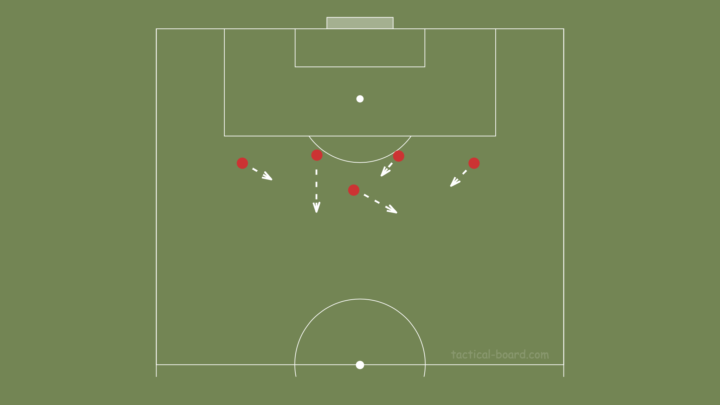
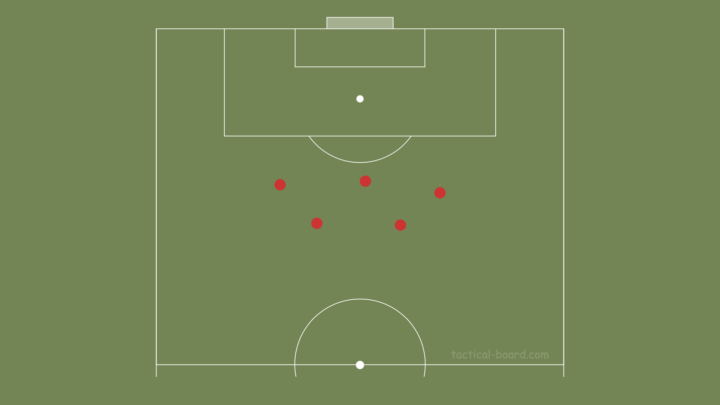
HJK deployed a 4-2-3-1 against Athletic Bilbao with Akseli Pelvas as the number ten. Pelvas can play as a striker as well and Bielsa might be preparing for HJK to use two attackers instead of one with this exercise. The drill is also used to hone the basic mechanisms of his five defensive players. The drill is revolutionary in all its simplicity.
Summary. Athletic Bilbao’s preparatory training session lasted a little less than an hour. In this article series about a 30 minutes of efficient training time was analysed. This process took almost two months. The break from football caused by Covid-19 enabled us to spend all this time to analyse the masterclass delivered by Bielsa in the late summer of 2012 in Helsinki. When we were following the training session in 2012 on the cliff overlooking the stadium, we had nowhere near the necessary knowledge to understand all that was going on in the field.
During the last eight years we were able to develop enough to fully appreciate the details of Bielsa’s methods in display during the session. Ultimately, it is all about the details. Analysing all the drills introduced in this series enforced that idea. When planning a training session one has to pay attention to every little detail from the position and colour of every cone to the exact order in which the players should perform their runs.
At the same time everything has to relate to everything. Starting from the principles to the subprinciples and then to the mechanisms. This is why Bielsa is a unique football coach. Through his way of looking and analysing football, he has changed the way how we play the game.
When analysing Bielsa’s methods and drills it is important to avoid copying. Copy pasting the drills introduced in this series will not make your players better. The key is in fully understanding where it comes from. Only with perseverance and hard work can one start to understand the tactical nuances on display here. That demands extreme passion for the game.
Bielsa was already successful in South America. In 2004 he coached the national team of Argentina to the victory in the Olympic Games held in Athens. La Albiceleste kept an empty sheet throughout the tournament and won the first Olympic gold medal for their country in any discipline since the Olympics of 1952 held in Helsinki.
Europe has been challenging continent for South American football coaches for a long time. In 2012 Athletic Bilbao reached the Europa League and Copa del Rey finals eventually losing both of them. However, on their way to the final they famously defeated Manchester United of Sir Alex Ferguson among other world-class opponents.
Multiple players who played in Bielsa’s Athletic Bilbao side in 2012 have established long and successful careers since then. These players include Kepa Arrizabalaga, Aymeric Laporte, Javi Martínez, Ander Herrera, Fernando Llorente and Aritz Aduriz.
Bielsa has received a lot of critique because of his emphasis on drills. He does not often use rondos or small-sided games in his training sessions. However, Bielsa has proved that his methods do work by gaining a promotion to the Premier League with Leeds United and playing an outstanding first season in the Premier League with a small budget.
We can discuss endlessly why Real Madrid or Manchester City will not hire Bielsa as their manager. However, his influence on the footballing world cannot be argued against. Bielsa bears comparison to the legendary Johan Cruyff in their efforts to reform and develop the game. Marcelo Bielsa, 64, has left an eternal handprint in football.

